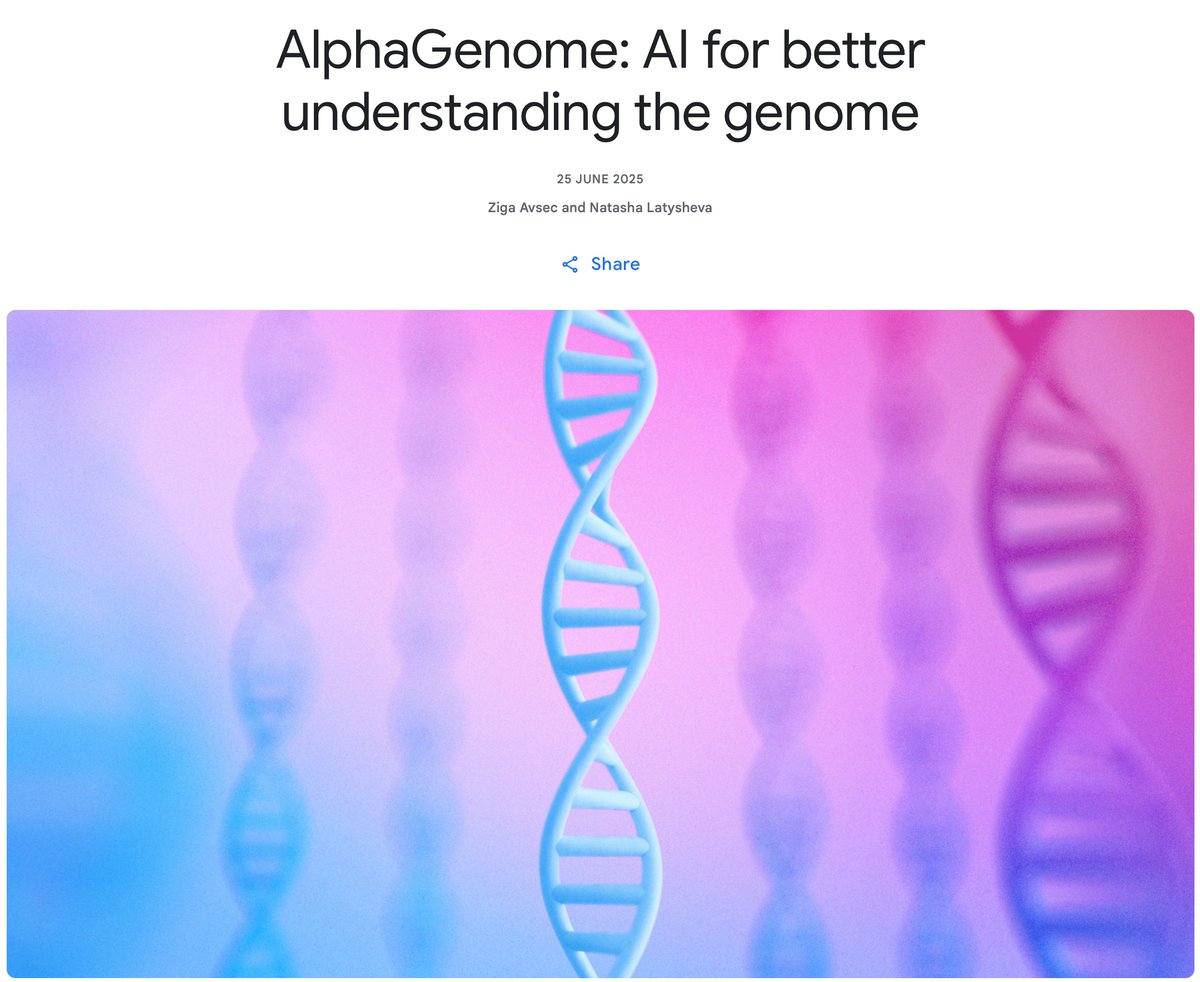holy shit, it’s here!
deepmind just released AlphaGenome.
an AI model that reads 1 million bases of DNA and predicts how any mutation changes molecular function
not just in single genes but across the entire regulatory genome.
DNA is code, and you are software
1/
deepmind just released AlphaGenome.
an AI model that reads 1 million bases of DNA and predicts how any mutation changes molecular function
not just in single genes but across the entire regulatory genome.
DNA is code, and you are software
1/

oh yeah, and it's an API
github.com/google-deepmin…
github.com/google-deepmin…
the human genome is 3 billion letters.
but less than 2% codes for proteins.
the other 98% is the regulatory machinery:
expression timing, chromatin architecture, RNA splicing, 3D folding etc
until now, we've been functionally blind to how it works.
AlphaGenome changes that
2/
but less than 2% codes for proteins.
the other 98% is the regulatory machinery:
expression timing, chromatin architecture, RNA splicing, 3D folding etc
until now, we've been functionally blind to how it works.
AlphaGenome changes that
2/

the core breakthrough: they solved a fundamental tradeoff.
old models had to choose:
- long-range vision, low resolution (blurred)
- sharp resolution, tiny context (myopic)
AlphaGenome does both.
1 million base context
1 bp resolution
simultaneously
3/
old models had to choose:
- long-range vision, low resolution (blurred)
- sharp resolution, tiny context (myopic)
AlphaGenome does both.
1 million base context
1 bp resolution
simultaneously
3/
what it predicts from pure sequence:
- gene expression across tissues
- splicing sites, usage, junctions
- chromatin accessibility (ATAC, DNase)
- histone modifications
- TF binding
- 3D contact maps
you input DNA, it outputs the functional state
4/
- gene expression across tissues
- splicing sites, usage, junctions
- chromatin accessibility (ATAC, DNase)
- histone modifications
- TF binding
- 3D contact maps
you input DNA, it outputs the functional state
4/
benchmarks are unmatched:
- beats specialist models in 22/24 track tasks
- outperforms others in 24/26 variant predictions
- predicts faster, with half the compute of Enformer
and unlike any other model, it does everything in one pass
5/
- beats specialist models in 22/24 track tasks
- outperforms others in 24/26 variant predictions
- predicts faster, with half the compute of Enformer
and unlike any other model, it does everything in one pass
5/

this isn’t academic abstraction.
they tested it on TAL1 mutations in T-ALL leukemia.
AlphaGenome predicted:
- creation of a MYB motif
- enhancer activation
- increased H3K27ac
- gene upregulation
a single base change → full regulatory cascade
6/
they tested it on TAL1 mutations in T-ALL leukemia.
AlphaGenome predicted:
- creation of a MYB motif
- enhancer activation
- increased H3K27ac
- gene upregulation
a single base change → full regulatory cascade
6/
this is the first model that:
- understands splicing at junction, site, and isoform levels
- sees regulatory interactions across 1Mbp windows
- predicts impact of variants in the non-coding genome
- resolves cause → mechanism → consequence
at single-nucleotide granularity
7/
- understands splicing at junction, site, and isoform levels
- sees regulatory interactions across 1Mbp windows
- predicts impact of variants in the non-coding genome
- resolves cause → mechanism → consequence
at single-nucleotide granularity
7/
use cases
- identify root causes of rare disease
- simulate mutations before testing
- design synthetic DNA with tissue-specific control
- prioritize therapeutic targets from GWAS
- predict off-target effects at the regulatory layer
the new backend for genomics
8/
- identify root causes of rare disease
- simulate mutations before testing
- design synthetic DNA with tissue-specific control
- prioritize therapeutic targets from GWAS
- predict off-target effects at the regulatory layer
the new backend for genomics
8/

obv there are limits:
- 100kb distal interactions still weak
- not calibrated for personal genomes (yet)
- doesn’t predict full phenotypes, only molecular outputs
- not clinical-grade (yet)
but this is version 1. trained in 4 hours. on half the compute of Enformer
9/
- 100kb distal interactions still weak
- not calibrated for personal genomes (yet)
- doesn’t predict full phenotypes, only molecular outputs
- not clinical-grade (yet)
but this is version 1. trained in 4 hours. on half the compute of Enformer
9/
the real innovation isn't just accuracy, it's unification.
before you'd need 10+ models to get a partial view of what a mutation does. now: one model, one API call, full resolution.
and because it's general-purpose, it can be fine-tuned for any context
10/
before you'd need 10+ models to get a partial view of what a mutation does. now: one model, one API call, full resolution.
and because it's general-purpose, it can be fine-tuned for any context
10/
deepmind is releasing API access for researchers now. full model to follow.
this is bio/acc baby
first AlphaFold solved protein structure.
now AlphaGenome makes gene regulation computable
11/
this is bio/acc baby
first AlphaFold solved protein structure.
now AlphaGenome makes gene regulation computable
11/
every failed therapy. every rare disease. every complex trait.
all of them start with misinterpreted DNA.
now we can finally see the system
12/
all of them start with misinterpreted DNA.
now we can finally see the system
12/
and when you can see a system clearly, you can begin to design it.
biology stops being mysterious. it starts becoming programmable.
this is the transition from description → control. AlphaGenome is the turning point
13/
biology stops being mysterious. it starts becoming programmable.
this is the transition from description → control. AlphaGenome is the turning point
13/
every disease has a regulatory fingerprint
every gene therapy fails when we misread context, and every mutation is a hypothesis waiting to be tested.
AlphaGenome is a general-purpose interpreter
shit's goig to get weird really fast
every gene therapy fails when we misread context, and every mutation is a hypothesis waiting to be tested.
AlphaGenome is a general-purpose interpreter
shit's goig to get weird really fast
• • •
Missing some Tweet in this thread? You can try to
force a refresh









